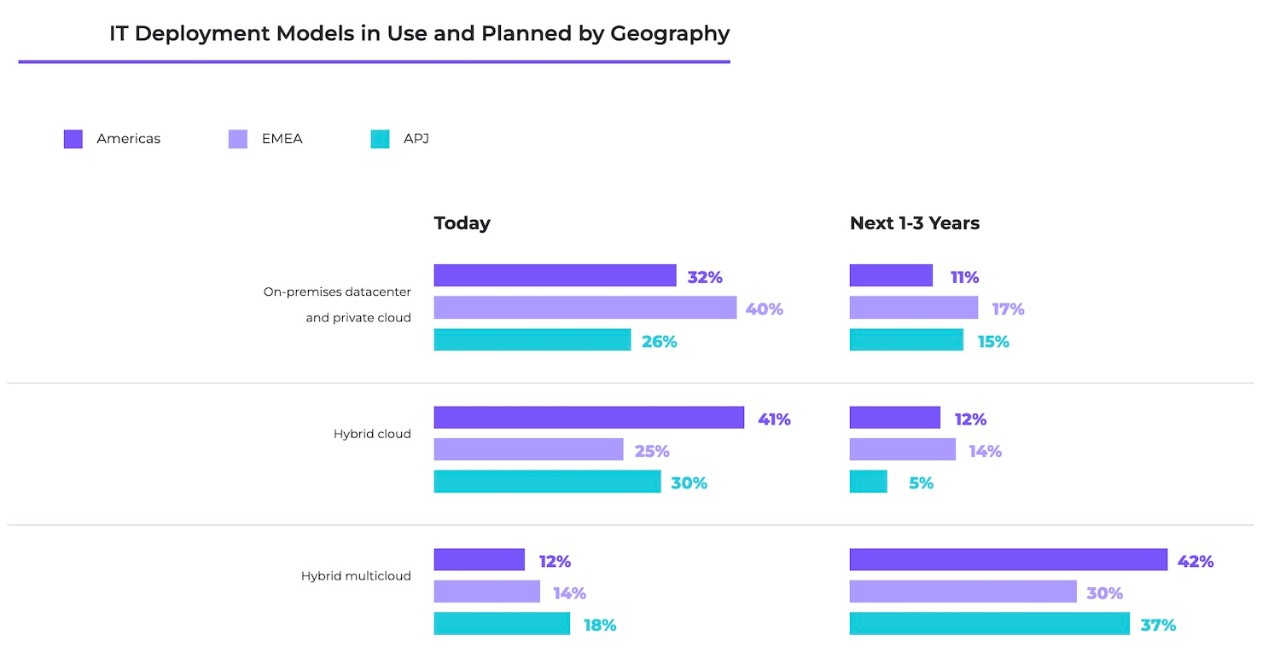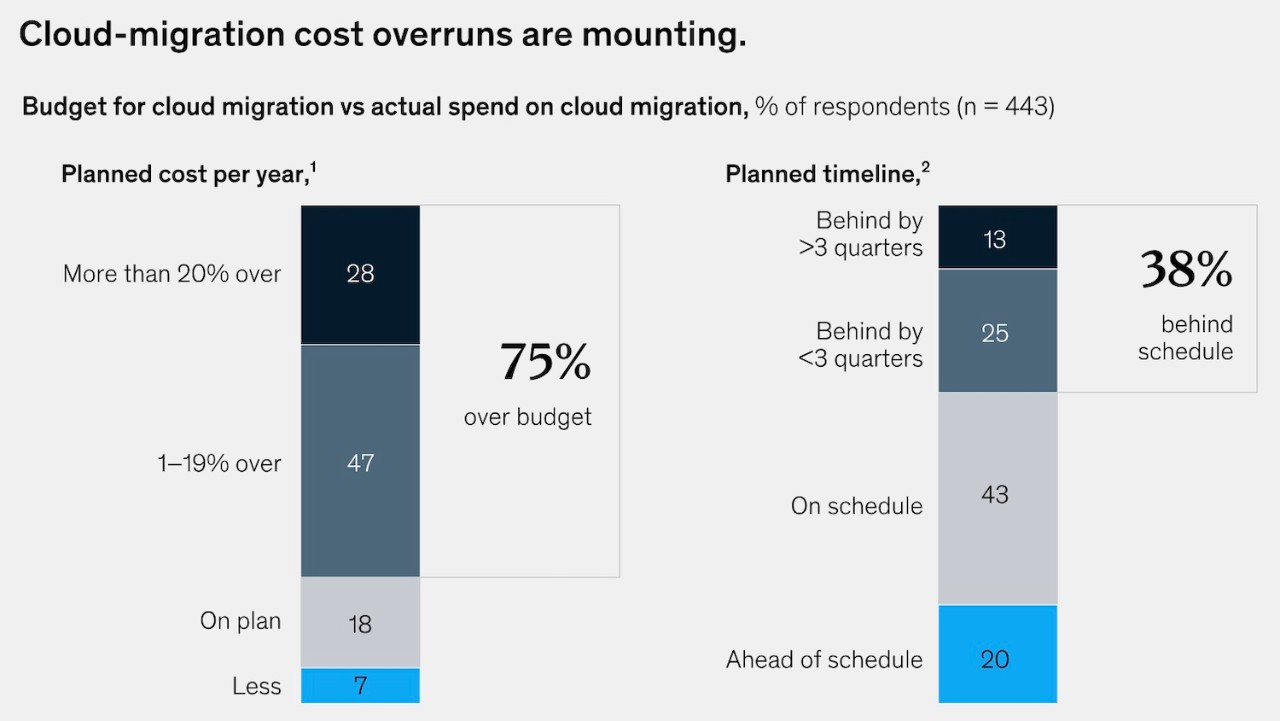Hybrid cloud has now been a central strategy for global IT departments for the better half of a decade. Since 2018, Nutanix Enterprise Cloud Index reports have consistently found that about IT decision makers view hybrid cloud as the ideal operating model for their enterprise.
The 2024 ECI Report found that hybrid cloud adoption has grown from a mere 12% in 2020 to 32% globally (slightly higher in the Americas at 41%), with an average additional 10% planning to adopt it in the next 1-3 years. Hybrid multicloud, while at much lower adoption rates currently (14% globally) is expected to see sharper increases in the next few years (36%).

This is certainly encouraging – growth in hybrid cloud adoption shows an increasing alignment between enterprise IT infrastructures and the decentralized hybrid or remote work environments most organizations now offer.
In addition, organizations want better control over their IT resources and the agility to respond to business demands at the fevered pace at which they emerge and evolve in 2024. IT leaders want to easily move workloads around converged public-private cloud environments in response to fluctuating costs, compliance and capacity requirements, and other variables.
Despite the clear hybrid multicloud vision among IT professionals, however, a wide gap exists between those who view hybrid cloud as their ideal model and those actually implementing it. To adopt hybrid cloud successfully, enterprise leaders must address common challenges and roadblocks that emerge in the process.
Getting Hybrid Off the Ground
Implementing hybrid cloud infrastructure isn’t a straightforward process.
“You don’t exactly go out and buy a hybrid cloud,” explained Deepak Mohan, research director for infrastructure systems, platforms, and technologies at IDC.
Instead, he said, hybrid clouds evolve in enterprises as separately-procured private and public cloud infrastructure components that eventually become integrated. All this generally happens alongside the decommissioning of older technologies and depends on emerging standards, APIs, tools and skill sets to make cloud integration possible.
As such, building a hybrid cloud is more of a journey than a defined purchase decision, and the necessary tools and skill sets are only just now starting to come into their own, Mohan said.
Nutanix ECI research over the past several years shows that enterprises are making progress with these foundational steps – establishing private clouds, upping public cloud infrastructure use, and beginning to invest in hybrid cloud solutions, all while reducing their dependency on non-cloud-enabled data centers.
These steps set the stage for individual private and public clouds to become integrated into a commonly managed and secured hybrid environment with seamless application and workload portability across private/public cloud borders.
CIOs and IT leaders then need to drive the process forward by setting a roadmap for hybrid cloud implementation. This, however, is where things often stall.
“Many businesses are aware of the benefits that a hybrid cloud approach can offer their organization yet remain uncertain about processes for implementation,” wrote Martin Hodgson, Director at Paessler AG. “That’s especially true when the same IT processes have been embedded in a company for decades.”
Technology and skills gaps, complex legacy systems, and resistance to change (among other challenges) can all impede an organization’s ability to successfully make the transition to hybrid cloud, even when they know it’s the right strategy.
It’s important to note, however, that these challenges are common. Pushing ahead despite these seemingly daunting barriers is what’s now separating innovative and forward-thinking companies from those stuck behind “the way we’ve always done it” thinking.
Understanding and addressing challenges that impede hybrid cloud adoption is essential to fully realize its benefits. These include skill shortages, compliance and security concerns, cost management, organizational and cultural barriers and complexity of oversight.
Skill Shortages
The cloud skills shortage is a pressing barrier impeding hybrid cloud adoption at a global level. Forbes recently reported that a staggering 95% of IT decision makers say their team has been negatively impacted by the cloud skills gap.
Enterprises must refuse to be victims of their internal skills shortages if they want to transform with hybrid cloud, turning to alternative solutions to fill the gaps.
“Addressing the cloud skills gap will require a blend of training and upskilling,” wrote Forbes Council Member and CEO of Nerdio, Vadim Vladimirskiy. “However, these efforts alone aren’t sufficient. We must also harness technologies like automation to lighten workloads and optimize resources.”
Compliance and Security Concerns
Maintaining compliance across complex hybrid cloud environments isn’t easy, especially in highly regulated industries. Public cloud environments, while flexible, come with specific security vulnerabilities that must be rigorously managed.
Enterprises need robust strategies to balance data privacy, system security, and threat protection with operational flexibility. Bolt-on approaches are no longer enough – security must be threaded into the fabric of an organization’s hybrid cloud management strategy.
Security issues like ransomware, malware, and data privacy are all top challenges enterprises are experiencing across their current IT infrastructures that can be mitigated with highly visible, integrated, centrally-managed hybrid cloud models.

Cost Management
Cost overruns are a major concern for enterprises embarking on the journey of hybrid cloud adoption. McKinsey reported that 75% of cloud migrations run over budget and 38% run behind schedule, incurring unplanned costs that can stall the process or require businesses to make tough decisions, like retiring applications rather than moving them.

A detailed roadmap that outlines both high-level phases of hybrid cloud adoption and specific, task-level deliverables is crucial for keeping the adoption process on track. Working with an expert service provider to guide the process is a best practice many enterprises now choose to mitigate this risk.
Organizational and Cultural Barriers
Resistance to change is a natural part of digital transformation but one that can hinder hybrid cloud adoption if not managed appropriately. Embracing hybrid cloud models often requires a cultural shift and alignment of hybrid cloud strategies with broader business goals.
“Many technology initiatives failed because of organizational resistance, cultural friction, and lack of readiness and support from stakeholders,” wrote Dr. Gary Wang in a recent article on why cloud success hinges on more than technology.
“As such, it’s imperative to take a human-centered approach to cloud migration to ensure the process is sustainable and worth the investment.
Leadership must foster a culture of innovation and adaptability, ensuring that hybrid cloud initiatives receive the necessary support and resources to succeed. At the same, IT teams must prioritize the user experience, communicate clearly, provide training, and demonstrate the user group-specific value being delivered by new hybrid cloud solutions.
Complexity of Oversight
Managing hybrid cloud environments demands ensuring seamless application and workload portability across private and public clouds, and interoperability between different cloud platforms. This requires advanced orchestration and management tools that centralize data and application management, provide ecosystem-wide visibility, and simplify oversight.
As organizations implement diverse hybrid environments they must also achieve the ability to oversee them holistically with centralized cloud management platforms like Nutanix.
Embracing the Power of Hybrid Cloud
There’s no doubt that hybrid cloud adoption comes with challenges that must be addressed with a combination of internal knowledge for context, external expertise and support, and the right tools and technologies to facilitate a seamless cloud journey. With hybrid cloud, enterprises can be empowered to continuously evolve and optimize their IT environments.
To this end, it’s crucial to keep in mind that hybrid cloud challenges don’t end with adoption. Its benefits are powerful, but the cloud is not the automatic best-choice location for every workload and application. In fact, Nutanix research has found in the past that enterprises were moving workloads to the cloud and then moving them back on-prem soon after—so we asked them why.
Security concerns with the public cloud was one of the top reasons mentioned, as well as faster data access to local apps compared to having to access the cloud over a wide-area network link. Today, edge computing is transforming capabilities around local accessibility, enabling rapid access to data from anywhere without necessarily relying on the public cloud.
In addition, cost dynamics are always changing, and it’s becoming common for applications to move back and forth as price points and app predictability changes.
With the right approaches and by addressing common hybrid cloud adoption challenges, enterprises can leverage hybrid cloud models to get the most out of new cloud capabilities and retain value from still-relevant on-prem and legacy systems.
All of this is to say – the power of hybrid cloud adoption is less about moving everything to the cloud and more about having the ability to keep every asset in your IT portfolio in its ideal place to maximize value and performance.
This is an updated version of “Hybrid Cloud Adoption: What are the Challenges?,” first published January 29, 2023.
Editor’s note: Learn more about the Nutanix Cloud Platform, which allows enterprises to run apps and data anywhere, and NC2, which reduces the operational complexity of hybrid multiclouds for a simpler, faster and more cost-effective way to extend, burst and migrate apps and data.
Michael Brenner is a keynote speaker, author and CEO of Marketing Insider Group. Michael has written hundreds of articles on sites such as Forbes, Entrepreneur Magazine, and The Guardian and he speaks at dozens of leadership conferences each year covering topics such as marketing, leadership, technology, and business strategy.
© 2024 Nutanix, Inc. All rights reserved. For additional information and important legal disclaimers, please go here.





